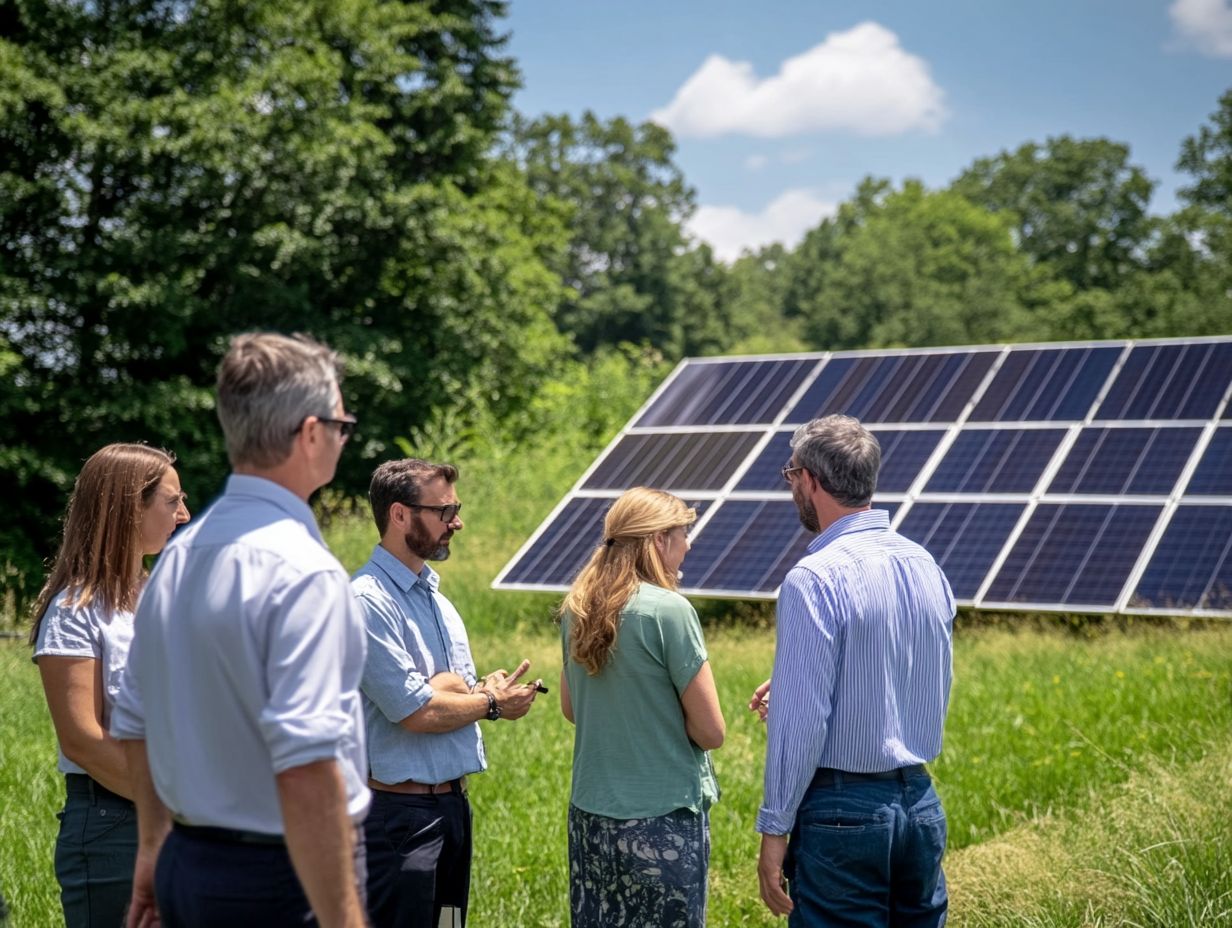Contents
Overview of Solar Energy: Applications and Benefits

You can harness solar energy from the sun’s rays, tapping into a clean and sustainable renewable energy source that’s becoming essential in the fight against climate change and reducing carbon footprints. Recent advancements in solar technology, including photovoltaic cells and solar panels, enable users to harness this abundant resource effectively for various applications—whether it’s powering your home or business, supporting agricultural initiatives, charging up electric vehicles, or even engaging in distributed generation.
Understanding how to use solar energy is key as we move toward a more sustainable future, promoting energy independence and energy efficiency.
In residential settings, solar energy installations are turning rooftops into mini solar power systems, allowing you to generate your own electricity and lower those pesky utility bills. If you run a business, you’ll find that more companies are jumping on the solar bandwagon to cut operational costs and boost their sustainability profiles, which is a great way to attract eco-conscious customers.
In the agricultural world, solar energy is powering irrigation systems, bringing down production costs, and supporting energy-hungry operations like refrigeration for perishable goods, utilizing solar thermal and concentrated solar power technologies. Plus, with solar technologies continuously evolving—think more efficient photovoltaic cells and innovative storage solutions—the potential for using renewable energy in your daily life is expanding, making it a more reliable and integral part of your energy options.
Green, M. A., Dunlop, E. D., Hohl-Ebinger, J., Yoshita, M., Kopidakis, N., & Hao, X. (2020). Solar cell efficiency tables (version 56). Progress in Photovoltaics: Research and Applications, 28(7), 629-638. Link
Recent Innovations in Solar Technology
The landscape of solar technology is changing fast, and you’re in for some exciting innovations that boost efficiency, affordability, and adaptability in harnessing solar energy.
For instance, have you heard about bifacial solar panels? They capture sunlight from both sides, which is pretty cool!
Plus, smart solar technology is stepping up the game by using artificial intelligence and machine learning applications to set new standards for energy generation.
And let’s not forget about advancements in solar tracking systems—they allow panels to follow the sun’s path, maximizing energy capture and making your transition to renewable energy solutions even more effective.
Emerging Technologies in Solar Energy
Explore the current trends shaping the future of solar technology.
Emerging technologies in solar energy are shaking things up when it comes to how you capture, store, and use solar power, paving the way for a more resilient and efficient energy future.
Innovations like solar batteries for energy storage and advanced solar inverters are boosting energy conversion, helping you get the most out of your solar power systems.
Plus, community solar projects are on the rise, giving more people access to solar energy without the hassle of individual installations—talk about a shared commitment to renewable energy!
With smart grid technology jumping into the mix, you can enjoy even greater benefits from these advancements, making real-time energy management and distribution a breeze.
Cutting-edge materials like perovskite solar cells are stepping up as strong contenders to traditional silicon cells, offering better efficiency and lower manufacturing costs.
These exciting solar developments not only enhance energy access for underserved communities but also play a significant role in the larger goal of reducing carbon footprints.
As research keeps pushing forward, the dream of widespread solar energy utilization becomes more and more realistic, setting the stage for a sustainable and equitable energy landscape that benefits everyone.
Trends in Solar Technology
The solar industry is riding a wave of trends that point to some serious growth and transformation in the renewable energy sector. As the solar market picks up speed, you’ll notice a bigger emphasis on energy transition strategies and the rollout of solar technologies in different sectors. The importance of renewable energy continues to grow, enhancing both SEO and user engagement.
With exciting advancements in solar energy storage solutions and solar policy incentives that encourage solar adoption, the future of solar power looks bright. Forecasts are showing that this expansion and integration into our energy landscape are only going to keep on growing.
Emerging Trends in Solar Energy Market

Current and future market trends in solar energy are pointing toward a solid path of increased investment and economic viability in the clean energy sector. With options like solar leasing and net metering becoming more accessible, you might find that integrating solar power systems into your home or business is more affordable than ever. For instance, a recent report indicates that solar installation costs have dropped by over 70% in the past decade, making it a more attractive option for consumers.
Plus, the rise of technology partnerships and innovative financing solutions is making the economics of solar energy even more compelling, positioning it as a prime option for sustainable development.
As you and many others look to cut energy costs and shrink your carbon footprint, the adoption of solar technology is picking up speed. In this changing landscape, financial tools like green bonds and solar power purchase agreements are becoming more popular, opening up attractive investment opportunities for those who want to invest responsibly.
Collaborations between solar manufacturers and financial institutions are leading to customized solutions that meet various market needs. These trends not only encourage the widespread adoption of solar energy but also strengthen its status as a viable alternative to fossil fuels, paving the way for a cleaner, more sustainable future for everyone.
Benefits of Using Solar Technology
The benefits of using solar technology are abundant, offering everything from environmental perks to solid economic gains that help build a sustainable future through increased energy resilience.
By tapping into renewable energy, you not only cut down on your carbon footprint but also boost energy independence and resilience.
Solar energy systems provide a clean alternative to traditional power sources, which means you can enjoy lower electricity bills while contributing positively to your finances and the planet’s sustainability efforts, further supporting the transition to renewable energy.
Environmental and Economic Benefits
Embracing solar technologies offers both environmental and economic benefits, creating a sustainable future. Solar energy brings some serious environmental perks your way, like cutting down on carbon footprints and boosting energy efficiency through renewable energy integration. When you switch to solar power, you’re not just saving money; you’re also helping to fight climate change and support a healthier planet.
Plus, using solar technology can lead to lower energy bills and create jobs in the booming renewable energy sector, fueled by the rise of solar startups and solar market growth.
Making the switch to solar doesn’t just reduce greenhouse gas emissions; it also helps your community become more resilient against those pesky fluctuations in energy prices. This flexibility is super important as more people and businesses jump on the solar bandwagon, paving the way for an economy that relies less on fossil fuels.
The solar industry is a job-generating machine, creating positions in manufacturing, installation, and maintenance, which helps build economic stability and growth. As the demand for renewable energy keeps climbing, the skills needed in this field are becoming more valuable, giving workers great opportunities to transition into this vibrant market with promising career prospects.
Embracing solar technologies is a total win-win—a cleaner environment and a thriving economy all rolled into one!
Challenges and Limitations of Solar Technology
Even though solar technology has a ton of advantages, there are still some challenges and limitations, like grid integration and solar financing, that can make it tough for you to fully embrace it.
You might run into issues like regulatory barriers, a lack of solid solar energy policies, and inconsistent solar legislation, which can really hold things back.
Then there’s the tricky business of integrating solar energy into the smart grid, which can be a real headache.
On top of that, you’ll also need effective solar monitoring systems and ongoing maintenance, which can add more stress for anyone looking to switch to solar power.
U.S. Department of Energy (DOE). (2020). A Guide to Community Solar: Utility, Private, and Non-profit Project Development. Link
Obstacles to Widespread Adoption

Several obstacles are standing in the way of widespread solar energy adoption, like outdated policies and the need for grid modernization to support solar microgrid and off-grid solar solutions. You might also notice community opposition and financing challenges making things tough for solar projects, which means it’s essential to tackle these issues to boost solar integration.
Understanding these roadblocks is key to creating a supportive environment for deploying solar technology and increasing solar energy capacity.
One of the biggest hurdles is policy inconsistency, which can create confusion for potential investors and make them hesitant to finance solar initiatives. Without clear regulations and solid incentives, public engagement suffers because many people are unsure about the long-term benefits of switching to solar energy.
Social acceptance is a big deal too; some communities may push back against solar installations due to concerns about aesthetics, land use, or the impact of solar farms.
So, if we can tackle these challenges together, we can pave the way for a more sustainable and solar-friendly future that benefits both the environment and local economies, supporting the energy transition and energy diversification.
How to Incorporate Solar Technology into Your Everyday Life
Incorporating solar technology into your life has never been simpler, with a ton of solar energy options out there to match your needs and lifestyle. Whether you’re thinking about off-grid solar solutions for that extra energy independence or checking out solar power purchase agreements for your home or business, there are definitely options that can work for you, including energy resilience and net-zero energy goals.
By understanding the practical steps to adopt solar energy, you can feel empowered to make informed choices that are good for both your wallet and the planet, considering factors like solar financing, solar incentives, and the environmental impact.
Tips for Implementing Solar Energy in Your Home or Business
Implementing solar energy at your home or business can be a game-changer that brings long-term benefits, like lower energy costs and improved energy efficiency. Start by figuring out your energy needs and looking into solar power systems that come with battery storage for the best energy management. Investing in solar charge controllers and solar inverters can also help you get the most out of your solar technology, ensuring maximum solar output and optimal energy yield.
To kick things off, you’ll want to conduct a thorough assessment of your current energy consumption. This means checking out your past utility bills to spot patterns and figure out when you’re using the most energy, aiding in the accurate solar resource assessment and solar performance analysis.
Once you have a good grasp of your energy demands, dive into researching different solar panel systems that fit your space and needs. Talking to local solar providers can give you valuable insights into both grid-connected and off-grid options, including community solar projects and hybrid systems.
Also, consider implementing energy-efficient practices, like upgrading your appliances and using smart home technology, to make your solar investment even smarter. Embracing energy diversification and solar applications can further enhance your overall energy resilience.
Ultimately, regularly keeping an eye on your system’s performance through solar monitoring and maintenance will help you harness the most energy while keeping those costs down, ensuring the sustainability and efficiency of your system.
Frequently Asked Questions
What are the latest innovations in solar technology and solar energy trends?

Some of the latest innovations in solar technology include solar-powered windows, solar shingles, bifacial solar panels, and the development of solar-powered cars and smart grids.
How do solar panels work?
Solar panels work by converting sunlight into electricity through the use of photovoltaic cells made of silicon. When sunlight hits the cells, it causes a flow of electrons, creating an electric current. Technological advancements in photovoltaic technology have significantly improved the efficiency and output of solar panels.
What are the benefits of using solar technology and solar energy systems?
Embracing solar technology offers numerous benefits.
Using solar technology can help reduce carbon emissions, save on electricity costs, and provide energy independence. It is also a renewable and clean energy source, contributing to the fight against climate change and promoting renewable energy adoption.
Current Trends in Solar Technology
Some current trends in solar technology include the use of artificial intelligence to optimize solar panel performance, the integration of solar technology in smart homes, and the development of solar-powered cars. Additionally, offshore solar installations and solar startups are contributing to the growth of the solar market.
Evolution of Solar Technology
Solar technology has evolved from bulky and expensive panels to more efficient and affordable options. There has also been a shift towards incorporating solar technology into everyday objects and structures, making it more accessible and convenient. The solar market has witnessed significant growth, with increased solar installations and advancements in solar design and architecture.
Future of Solar Technology
The future of solar technology looks promising, with advancements in energy storage and efficiency. It is also expected to become more integrated with other technologies, such as electric vehicles and smart grids. Solar energy solutions will continue to evolve, with a focus on distributed generation, solar microgrids, and climate resilience. These advancements will play a vital role in sustainable energy solutions.







